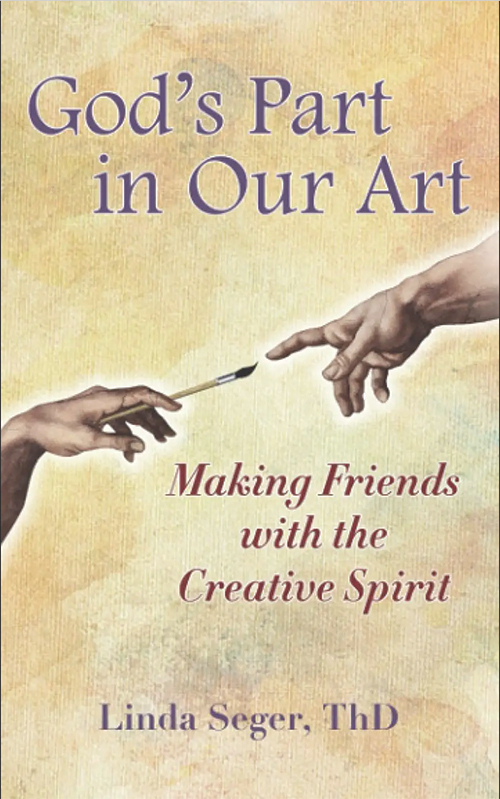
God’s Part in Our Art: Making Friends with the Creative Spirit
Reviewed by William Shetter
October 1, 2022
By Linda Seger. Red Typewriter Press, 2021. 232 pages. $19.95/hardcover; $12.95/paperback; $4.99/eBook.
Artistic creation has a well-established and hardly controversial ability to express spirituality. But this book goes well beyond this idea and claims broadly that not only is all creativity artistic, but it is unavoidably spiritual. How can author Linda Seger be so sure of this? Because all our creative acts follow in lockstep the greatest creative act of all, told in the first few verses of the Book of Genesis, where she secures the unfolding of this idea.
Seger entertains no doubt that all who create are in some form artists. Creativity, she assures us, taps into something which is greater than ourselves, because “our creative selves and our spiritual selves intersect.” The term “artist” includes writers, visual artists, dancers, actors, and musicians, but it also includes “a person who doesn’t have an art form but approaches life in a creative way” (emphasis added). As we go on, we need to make sure we remember this crucial assurance. I’ve italicized it because as the book’s discussion proceeds (especially in the later chapters, the focus is so strongly on career artists) with references to “us, the artists,” “art forms,” “the artist’s ego,” and the like, the rest of us could easily feel marginalized or even excluded.
Seger’s own creative activity has earned her the right to convictions about artistic creativity. Besides award-winning piano performance, she has spent years in theater direction and screenwriting. A number of books have been the result of her serving as script consultant in the film industry.
Following these confident definitions, five chapters turn to the beginning of Genesis to demonstrate the pattern of the divine creative process in which we can all participate.
To make sure we remember that quote above, let me first take a moment aside here. I live in a retirement community, and it includes a well-provisioned crafts room. Many of the residents gather here regularly, and under expert guidance and encouragement are able to produce modest paintings, watercolors, sculptures, collages, and the like, often of astonishing creativity and occasionally real beauty. The point here is that none of them previously thought of themselves as anything like a “creative artist.”
In the broadest sense, creating something—no matter how trivial—is simply giving outward shape to a fresh idea in one’s mind. Now, on opening the Bible to the beginning of Genesis, we can see the first steps involved. Any creativity begins with the creative spark, and this idea is an emanation of the Spirit. The creation takes place in the void, bringing something forth out of nothingness. Now we do not dive in, but hovering must happen as we move into mystery, the act of centering and listening to what is deep within. A light shines on what was previously unformed, and in order to do the best, we must learn to recognize the distinction between good and bad. This crucial evaluation, Seger tells us, is the last major step in the creative process. Now we discover that we have covered all the crucial steps in creativity in no more than the first four verses of the book of Genesis.
She is careful to make clear that while the thing created is not inherently spiritual—although it may of course have spiritual content—it is the process of creation that is always a spiritual act. This spirituality confronts us with a whole array of matters which—if our creativity is to have depth—are crucial to find in ourselves. The purpose of all the rest of the chapters is to show the many ways creativity impacts and forms the personal lives of all of us, not just the recognized artists.
Many of us have felt, as she reminds us, that a lot of our creative work is going on beneath the surface; we’re allowing something to happen we don’t quite control. Another familiar feeling is that creativity brings with it a sense of joyfulness (modeled on Lady Wisdom in Proverbs 8:30). Who has not felt a little thrill of satisfaction after even the most humble creative act? Resting (Gen. 2:3) can be as important as the doing. Rest is the quiet time in our creativity. And as we create, we are blessing others (Gen. 1:28). Finally, for everyone, it is the creative spirit in all of us that lifts us out of despair and emptiness, and brings wholeness and completion.
We sit up and take special note when she assures us several times that creating is becoming more truly ourselves: as we create, we are growing into the self we were created to be. She concludes with “Being in the image of God is to be creators and co-creators.” We may end up asking that if any act of creativity is artistic, is that word “Part” in the title a bit too modest?
William Shetter is celebrating his fifty-sixth year of membership in Bloomington (Ind.) Meeting.



Comments on Friendsjournal.org may be used in the Forum of the print magazine and may be edited for length and clarity.